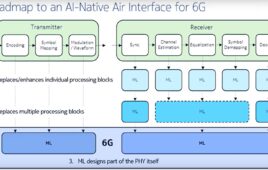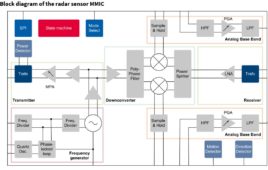One of the market’s newest automotive sensors guarantees cars will receive a degree of x-ray vision, allowing these vehicles to “see” in and around a car without cameras—and at a fraction of the cost for most other sensors. The device in question is a 3D imaging sensor that was developed based on a form of radio frequency (RF) technology, which has been around since the 1960s. This technology is called ultra-wideband (UWB), and was originally utilized in radar systems by the U.S. military.
The sensor is being developed by Vayyar, an Israel-based company, who exhibited the device at CES in Las Vegas last week. UWB garnered some attention in the early 2000s, but was overshadowed by the rises of other communicative technologies like Bluetooth and WiFi. Vayyar recently closed a $45 million Series C financing round for its array of UWB-enabled applications that include medical imaging, smart home and automotive applications. The UWB comes in the form of a sensor chip that contains 24 transceivers, which run in frequencies from 0-20 GHz (is soon expected to feature 72). Most chips only contain one to three transceivers, which gives the UWB chip a degree of high-resolution imaging that hasn’t been achieved before.
In 2011, researchers at Germany’s University of Duisburg-Essen published a paper on 3D UWB, where they wrote, “Due to the large range of available frequencies (and especially the lower ones), UWB radar systems are able to penetrate dielectric materials to perform subsurface imaging.” The chip essentially contains x-ray vision, enabling the device to see through objects and people with the exception of non-ionizing radiation (meaning it’s safe for humans).
Contrary to traditional UWB devices, the chip’s sensors release thousands of signals that create hundreds of thousands of points in space, which are then analyzed in real time. Originally commercialized back in 2011, the technology was initially applied to medical testing, namely hardware and software for early detection of breast cancer. The aim was for these chips to help women (particularly living in poor or remote regions) get regular examinations in a less expensive and painful manner.
UWB’s broad appeal has prompted Vayyar to insert itself in multiple markets that largely involve smart home and automotive technology. The UWB chip has the ability to emulate some qualities found in lidar, a technology found in connected and autonomous cars that’s been driving up their prices. Another upside behind the 3D UWB sensor is how the chip can be a potential step up from lidar regarding aesthetics and practicality. The interior sensors can detect valuable information occurring inside the car, like if people are seated inside of a steering wheel-less vehicle so the right airbags can be deployed in an accident. In addition, current lidar and camera sensors are quite large and mounted atop car roofs, whereas the UWB sensor is small enough to be placed in seats, doors, and dashes.




